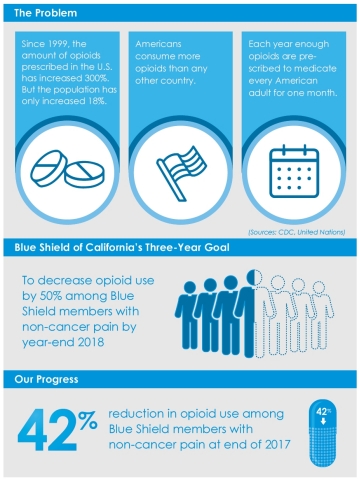SACRAMENTO, Calif.--(BUSINESS WIRE)--The overall consumption of opioids among Blue Shield of California members with non-cancer pain has fallen by 42 percent since the nonprofit health plan launched its Narcotic Safety Initiative in 2015 to help solve the public health epidemic.
Blue Shield’s initiative is on track to meet its goal of reducing inappropriate prescribing and overuse of opioid narcotic medication use among its health-plan participants by 50 percent by the end of 2018.
Since 2015, the average daily dose prescribed for chronic users also fell by 18 percent. The latest figures, based on year-end 2017 results, were announced today at the 2018 Northern California State of Reform Health Policy Conference in Sacramento where hundreds of policymakers, elected officials and healthcare stakeholders gathered to discuss healthcare-related issues.
“We continue to make headway on achieving our objectives through evidence-based interventions,” said Salina Wong, PharmD, Blue Shield’s director of clinical pharmacy programs. “There are treatment options that can be just as effective, or more so, than opioids, which is why our efforts focus on reducing first-time use of these medications.”
The Narcotic Safety Initiative’s objectives are to:
- Reduce the number of people on chronically high doses of opioids.
- Prevent members who are newly starting opioids from progressing to chronic use.
- Reduce the number of prescriptions and refills written for members who are newly starting opioids.
Blue Shield’s evidence-based interventions have included:
- Prescriber education programs that promote prudent prescribing and proactive management of opioids by medical prescribers.
- Access to programs for health plan members to help manage pain, addiction and substance abuse.
- Improved formulary access to medication-assisted treatments for treatment of substance abuse.
- Diligence on detecting and managing fraud, waste and abuse.
“We also emphasize to both doctors and their patients the importance of using the lowest dose possible of opioids when opioids are needed and having a plan to taper off after starting an opioid medication,” Wong said. “Our initiative strives to ensure that prescribers and members have the knowledge and resources they need to prevent a potentially deadly addiction to opioids.”
Since 1999, opioid prescriptions in the United States have tripled, leading to a cascade of interrelated health, social, and economic problems. In addition, accidental deaths from drug overdoses exceed those caused by motor vehicle accidents and firearms, and more of these deaths are caused by prescription opioids (primarily hydrocodone and oxycodone) than heroin and cocaine combined. In the same period, hospital admissions for opioid addiction treatment have increased five-fold, and five times as many babies now need treatment for opioid exposure.
In the past year, Blue Shield has hosted a provider education series with expert speakers addressing issues such as how to taper patients to lower doses or help them stop using opioids altogether; when and how to start and taper opioid treatment if it is needed; and medication-assisted treatments for patients with opioid use disorder. Additionally, experts have engaged selected high-risk member groups to talk about opioid use and treatment for substance abuse. Education and awareness is a first and important step to reducing over-prescribing and over-use of opioids.
Blue Shield also has participated in national, state and local task forces, which has helped to reduce new prescribing of opioids in emergency rooms and to identify policies that have the greatest impact on the opioid epidemic.
About Blue Shield of California
Blue Shield of California, an independent member of the Blue Cross Blue Shield Association, is a nonprofit health plan with 4 million members, 6,800 employees and more than $17 billion in annual revenue. Founded in 1939 and headquartered in San Francisco, Blue Shield of California and its affiliates provide health, dental, vision, Medicaid and Medicare health care service plans in California. The company’s mission is to ensure all Californians have access to high-quality care at an affordable price. Blue Shield has contributed more than $500 million to Blue Shield of California Foundation. Contact your local agent or broker about Blue Shield of California products and services or visit www.blueshieldca.com.




